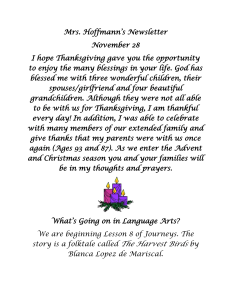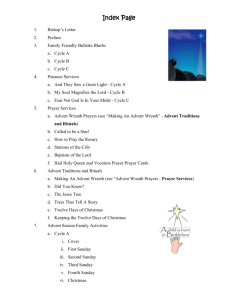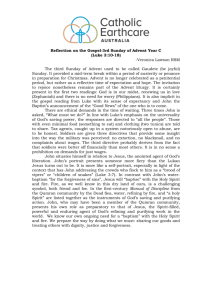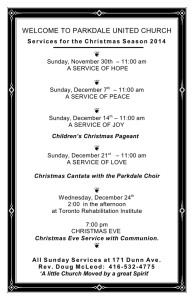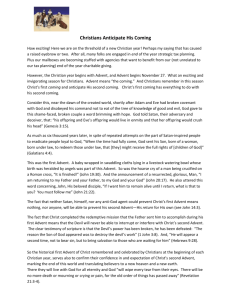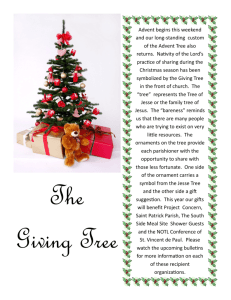File - aquireligion
advertisement
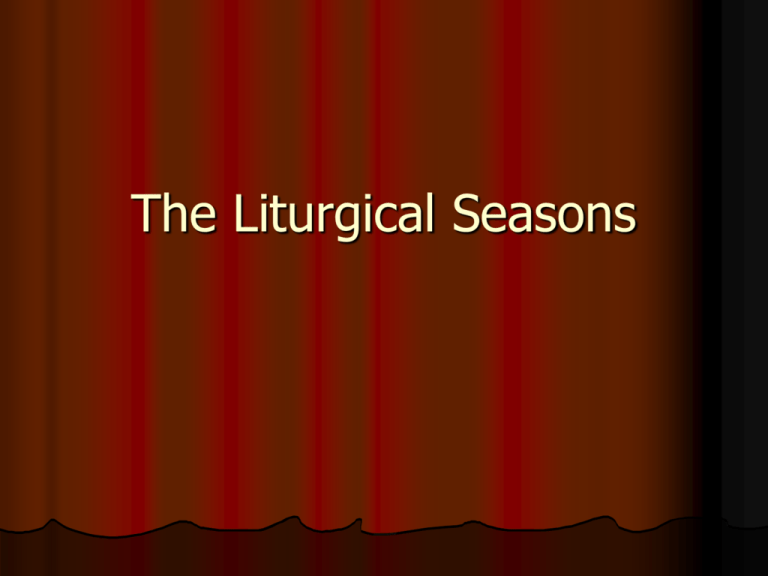
The Liturgical Seasons The Liturgical Season The calendar of the Church in which determines when Feasts, Memorials, Commemorations, and Solemnities are to be observed and which portions of Scripture are to be read Advent a time of preparation for Christmas during Advent we prepare our hearts to “receive” Jesus into the world each year as a light to the nations also a time of looking forward to Christ’s Second Coming in the last days. The third Sunday of Advent is called Gaudete Sunday The liturgical color for Advent is violet, a deep bluish red (often mistakenly called “purple”) symbolizing mourning and penance. On Gaudete Sunday, however, rosecolored vestments may be used for this joyful day. Advent Wreath The Advent wreath is part of our long-standing Catholic tradition. pre-Christian Germanic peoples using wreathes with lit candles during the cold and dark December days as a sign of hope in the future warm and extendedsunlight days of Spring. Advent Wreath Scandinavia during Winter, lighted candles were placed around a wheel, and prayers were offered to the god of light to turn “the wheel of the earth” back toward the sun to lengthen the days and restore warmth Advent Wreath Christians adapted this tradition and used Advent wreathes as part of their spiritual preparation for Christmas Christ is “the Light that came into the world” to dispel the darkness of sin and to radiate the truth and love of God (cf. John 3:19-21) Symbolisms of the Advent Wreath made of various evergreens, signifying continuous life laurel signifies victory over persecution and suffering pine, holly, and yew, immortality cedar, strength and healing Symbolisms of the Advent Wreath Holly also has a special Christian symbolism: The prickly leaves remind us of the crown of thorns, and one English legend tells of how the cross was made of holly. The circle of the wreath, which has no beginning or end, symbolizes the eternity of God, the immortality of the soul, and the everlasting life found in Christ. Symbolisms of the Advent Wreath the wreath of evergreens depicts the immortality of our soul and the new, everlasting life promised to us through Christ, the eternal Word of the Father, who entered our world becoming true man and who was victorious over sin and death through His own passion, death, and resurrection Symbolisms of the Advent Wreath candles represent the four weeks of Advent each week represents one thousand years, to sum to the 4,000 years from Adam and Eve until the Birth of the Savior Three candles are purple and one is rose Symbolisms of the Advent Wreath The purple candles in particular symbolize the prayer, penance, and preparatory sacrifices and goods works undertaken. The rose candle is lit on the third Sunday, Gaudete Sunday, when the priest also wears rose vestments at Mass Symbolisms of the Advent Wreath Gaudete Sunday is the Sunday of rejoicing, because the faithful have arrived at the midpoint of Advent, when their preparation is now half over and they are close to Christmas Some modern day adaptions include a white candle placed in the middle of the wreath, which represents Christ and is lit on Christmas Eve Symbolisms of the Advent Wreath Another tradition is to replace the three purple and one rose candles with four white candles, which will be lit throughout Christmas season. Christmas (December 25) the Church observes the birth of Jesus we celebrate the Word become flesh, coming to dwell among us as the light of the human race The Octave of Christmas (octave means eight; hence the octave of Christmas lasts for eight days) begins with Christmas day and ends after the Solemnity of Mary, Mother of God. Epiphany commemorates the recognition of Jesus as the Son of God by the three Wise Men The season of Christmas ends on the Monday after the Solemnity of the Baptism of the Lord, which signifies the purification of the world, through Christ himself. All three gifts are ordinary offerings and gifts given to a king. Myrrh being commonly used as an anointing oil, frankincense as a perfume, and gold as a valuable. spiritual meaning : gold as a symbol of kingship on earth, frankincense (an incense) as a symbol of priestship, and myrrh (an embalming oil) as a symbol of death. gold symbolizing virtue, frankincense symbolizing prayer, and myrrh symbolizing suffering. The liturgical color of the season of Christmas is white, symbolizing purity and joy. Ordinary Time Two periods in the Roman calendar are called Ordinary Time . The first period “begins on Monday after the Sunday following Epiphany and continues until Tuesday before Ash Wednesday, inclusive ” The second period begins “on Monday after Pentecost and ends before Evening Prayer I of the First Sunday of Advent” This time is called “ordinary” because it is, well, ordinary; that is, not part of any special liturgical season. Weekdays during Ordinary Time on which no solemnities, feasts, or memorials of saints fall are called ferial days. The liturgical color of Ordinary Time is green, symbolizing life and hope. Lent The liturgical season of Lent by lasts for 40 weekdays in remembrance of the 40 days and nights that Christ spent fasting in the desert, tempted Satan. The beginning of Lent, Ash Wednesday, is therefore dependent on the date of Easter. Easter The season of Easter begins at the Easter Vigil the week previous to Easter is called Holy Week; it begins with Passion Sunday (Palm Sunday). On Passion Sunday the Church celebrates Christ’s riding into Jerusalem on a road strewn with cloaks and leafy branches as he set about to accomplish his paschal mystery The season of Easter comes to a close, and Ordinary Time returns, on the Monday after Pentecost Sunday (from the Greek pentekoste, fiftieth day) on which we celebrate the descent of the Holy Spirit (Acts 2:1-13). The liturgical color of the season of Easter is white, symbolizing purity and joy. Red, the color of passion, is used on Passion (Palm) Sunday and Good Friday. Red, symbolizing fire, is also used on Pentecost Sunday. a time of penance, so that the faithful may share in the joys of Easter Sunday with purity of heart The three traditional forms of penance, fasting, prayer, and almsgiving, “express conversion in relation to oneself, to God, and to others” (Catechism of the Catholic Church, 1434) The liturgical color of Lent is violet, just as for Advent. Rose-colored vestments, however, may be used on the Fourth Sunday of Lent, called Laetare Sunday from the first words of that day’s Introit at Mass, Laetare Jerusalem (“Rejoice, O Jerusalem”). The Liturgical Colors White (light, innocence, purity, joy, triumph, glory) Season of Christmas Season of Easter Feasts of the Lord, other than of His passion Feasts of Mary, the angels, and saints who were not martyrs All Saints (1 November) Feasts of the Apostles Nuptial Masses Masses for the dead (Requiem Masses) when the deceased is a baptized child who died before the age of reason Red (the Passion, blood, fire, God’s Love, martyrdom) Feasts of the Lord's passion, Blood, and Cross Feasts of the martyrs Palm Sunday Pentecost Green (the Holy Ghost, life eternal, hope) Time After Epiphany Time After Pentecost Violet (penance, humility, melancholy) Season of Advent Season of Septuagesima Season of Lent Rogation Days Ember Days (except for Pentecost Ember Days) Vigils except for Ascension and Pentecost Good Friday Black (mourning, sorrow) All Souls Day Masses for the dead (Requiem Masses), except for baptized children who've died before the age of reason Rose (joy) Gaudete Sunday (Third Sunday of Advent) Laetare Sunday (Fourth Sunday of Lent) The Holy Days of Obligation Immaculate Conception (Dec. 8) Pius IX pronounced and defined that the Blessed Virgin Mary "in the first instance of her conception, by a singular privilege and grace granted by God, in view of the merits of Jesus Christ, the Saviour of the human race, was preserved exempt from all stain of original sin." Christmas Day (December 25) Solemnity of the Motherhood of Mary (Jan.1)
